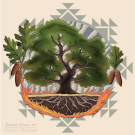Stewards of the Land - Cultural Fire
HS-LS2-6, HS-LS2-7, HSS 10.4.2, HSS 10.4.3, HSS-PoAD.12.2This multi-lesson series explores the deep historical and cultural relationship California Native Tribes have with the land, focusing on how cultural burning continues to be used as a vital component of land stewardship. Students will gain insight into the significance of fire in Indigenous cultures and how it was essential for maintaining ecosystems and cultural practices. Through a combination of poems, videos, imagery, timelines and readings, the lessons will highlight the ongoing efforts by Native peoples to restore their relationship with the earth and their traditional fire practices. The series begins with an introduction to Indigenous land stewardship, where students will learn about the role of fire in managing the land, including how fire helps regenerate important plants like acorns, which are vital to Indigenous cultures. Students will have the chance to compare and contrast the Indigenous and colonial views on land management, especially fire suppression. As the series progresses, students will understand how Historical US suppression policy has created a devastating impact that began in 1850, which criminalized Indigenous fire practices. Students will learn about the efforts of Indigenous groups to work, such as the Karuk and Yurok Tribes, to revive cultural burning as a tool for ecological restoration. This will lead into discussions of living in balance with nature, a stark contrast to the Western concept of nature as a resource to be exploited. By the end of the lesson series, students will understand how Indigenous practices like cultural burning can heal the land and how these practices challenge the commodification of nature prevalent in Western conservation. Ultimately, the series aims to show students why it is crucial to respect and include Indigenous voices and knowledge in addressing today’s environmental challenges.
